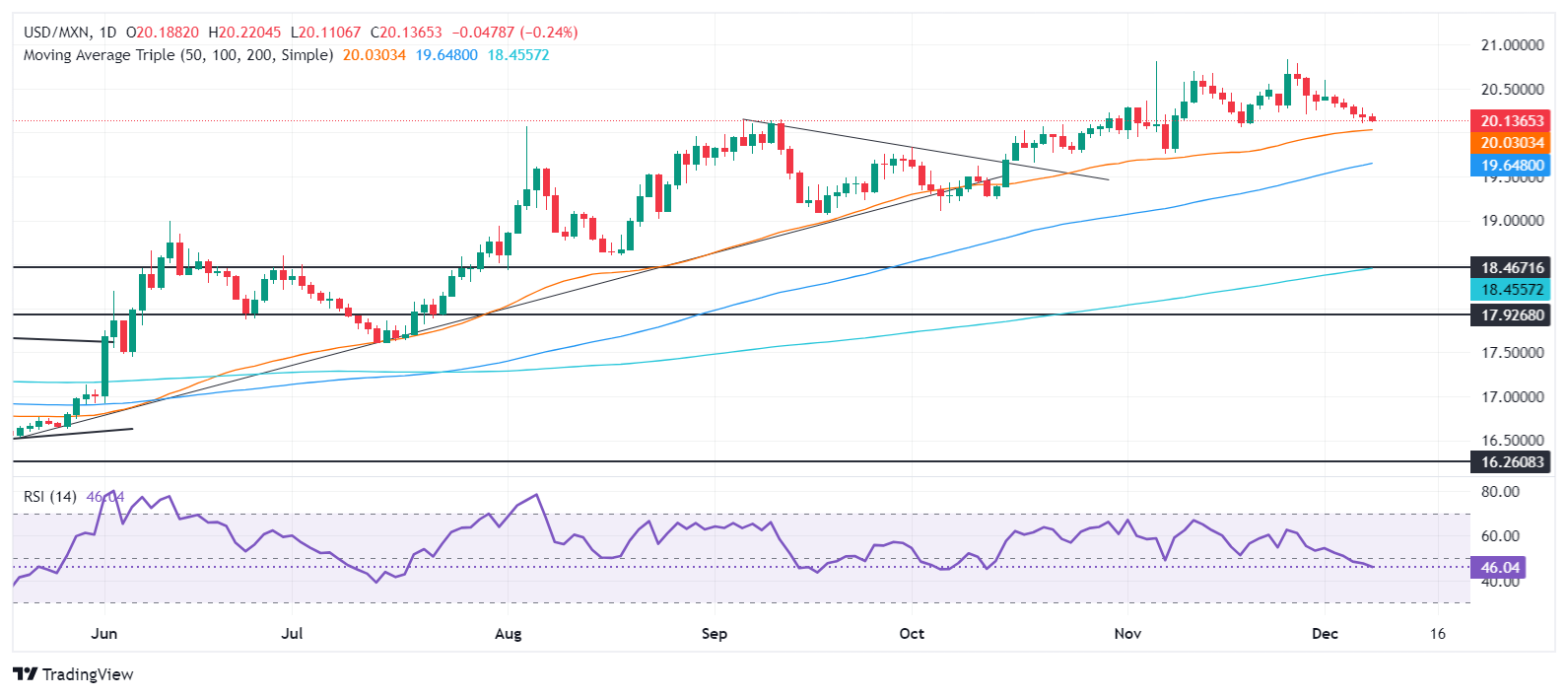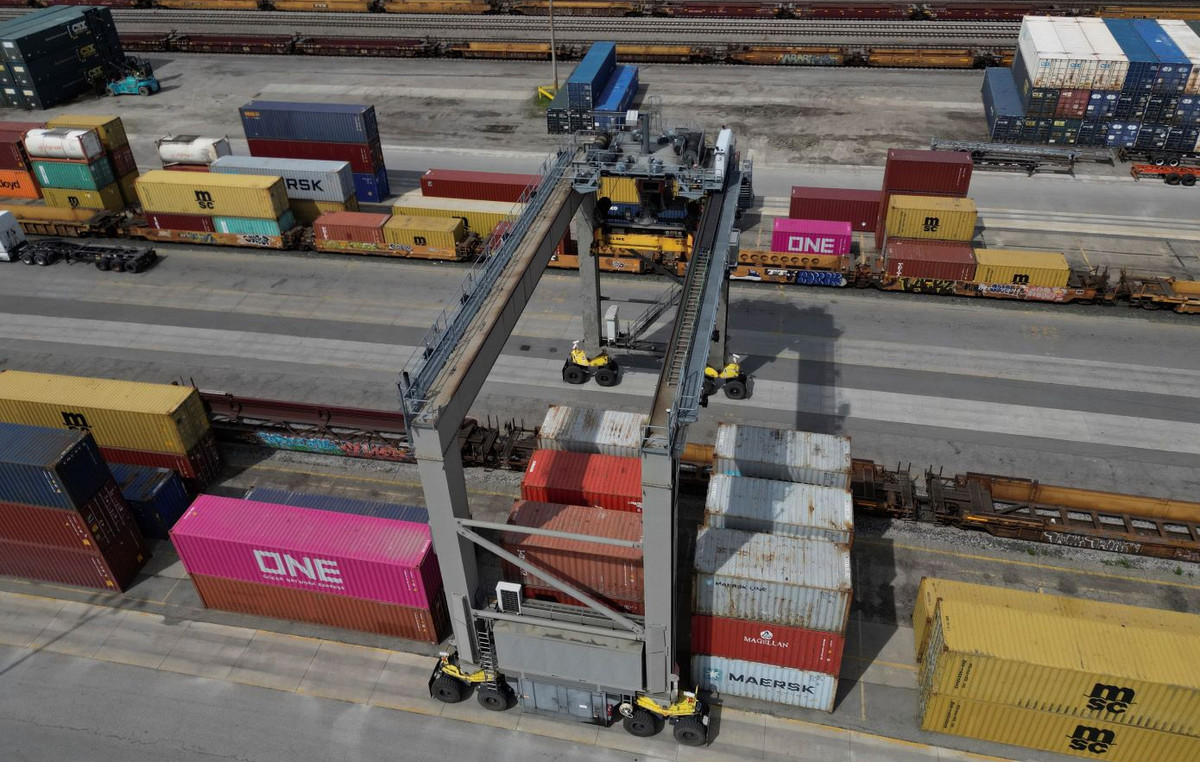- The Mexican Peso strengthens as November inflation eases, suggesting potential for continued rate cuts.
- Banxico’s governor takes a cautious stance on aggressive rate cuts despite lower inflation.
- Upcoming economic releases include consumer confidence in Mexico and the US CPI, with markets watching for more clues on monetary policy.
The Mexican peso extended its rally for the fifth consecutive day as inflation in Mexico fell to its lowest level since April 2024. Although this suggests that the Bank of Mexico (Banxico) could continue its easing cycle, the USD/MXN fell 0.06% and was trading at 20.14 at the time of writing.
Mexico’s economic agenda revealed that headline and underlying inflation in November fell short of estimates, falling after the Consumer Price Index (CPI) reached its highest level of 5.57% in July, according to the National Institute of Statistics Geography and Informatics (INEGI).
Last week, Banxico Governor Irene Espinosa was hawkish, saying, “At this point, too many things need to change for us to believe that the conditions are right for a much more aggressive movement.” His statement followed a consultation on the possibility of a cut of more than 25 points.
Across the border, the latest US Nonfarm Payrolls (NFP) report in November was spectacular. The economy added 227,000 jobs to the workforce, exceeding estimates of 200,000, although the unemployment rate rose from 4.1% to 4.2%.
Federal Reserve (Fed) officials have begun their blackout period ahead of the December 17-18 monetary policy meeting. Policymakers did not provide any clues about the meeting, with most supporting a gradual approach. They are awaiting November Consumer Price Index (CPI) data on December 11.
This week, Mexico’s economic agenda will include data on consumer confidence and industrial production. In the US, the Consumer Price Index, Producer Price Index and initial jobless claims data will also attract traders.
Daily Market Summary: Mexican Peso Ignores Mild Inflation, Appreciates
- Mexico’s headline inflation fell from 4.76% to 4.55% year-on-year, below forecasts of 4.60%, its lowest level in eight months.
- The underlying figures showed an improving disinflation process with November falling from 3.80% to 3.58%, below projections of 3.6%.
- “Mexican inflation continues to decline slightly and underlying pressures are under control. We believe that the general CPI will increase around 0.5% monthly in December, and that the annual rate will close 2024 at 4.4%,” explained Andrés Abadía, chief economist for LATAM at Pantheon Macroeconomics.
- Banco Base economist Gabriela Siller said, “The Bank of Mexico is expected to cut interest rates by 25 basis points on December 19. By 2025, inflation is expected to decline to close the year at 4.1%, and the Bank of Mexico will cut the interest rate to 8.5%.”
- Money market futures price in a 90% chance that the Fed will cut borrowing costs by 25 basis points this month, according to the CME’s FedWatch tool.
- Banxico’s November survey shows that analysts estimate Mexican inflation at 4.42% in 2024 and 3.84% in 2025. Core inflation figures will remain at 3.69% in 2024 and 2025. GDP is expected to be 1.55% and 1.23% for 2024 and 2025, respectively, and the USD/MXN exchange rate at 20.22 for the rest of the year and 20.71 in 2025.
Mexican Peso Technical Outlook: USD/MXN Falls Below 20.20 on Peso Strength
USD/MXN fell as low as 20.09 last Friday, near the 50-day SMA at 20.00. The momentum shifted to the downside as the Relative Strength Index (RSI) turned bearish, indicating that the exotic pair could test the 20.00 mark.
In that case, the next support would be the 100-day SMA at 19.61 before testing the psychological mark of 19.50, before the 19.00 figure. Otherwise, if USD/MXN rises above the December 6 high of 20.28, that could pave the way to challenge 20.50, before the yearly high of 20.82, followed by the 21.00 mark.
The Mexican Peso FAQs
The Mexican Peso (MXN) is the most traded currency among its Latin American peers. Its value is largely determined by the performance of the Mexican economy, the policy of the country’s central bank, the amount of foreign investment in the country and even the levels of remittances sent by Mexicans living abroad, particularly in the United States. . Geopolitical trends can also affect the MXN: for example, the nearshoring process (or the decision by some companies to relocate manufacturing capacity and supply chains closer to their home countries) is also seen as a catalyst for the currency. Mexican, as the country is considered a key manufacturing center on the American continent. Another catalyst for the MXN is oil prices, as Mexico is a key exporter of the raw material.
The main objective of Mexico’s central bank, also known as Banxico, is to keep inflation at low and stable levels (at or near its target of 3%, the midpoint of a tolerance band between 2% and 4%. %). To do this, the bank establishes an appropriate level of interest rates. When inflation is too high, Banxico will try to control it by raising interest rates, which makes borrowing more expensive for households and businesses, thus cooling demand and the economy in general. Higher interest rates are generally positive for the Mexican Peso (MXN) as they lead to higher yields, making the country a more attractive place for investors. On the contrary, lower interest rates tend to weaken the MXN.
The publication of macroeconomic data is key to evaluating the state of the economy and can have an impact on the valuation of the Mexican peso (MXN). A strong Mexican economy, based on high economic growth, low unemployment and high confidence is good for the MXN. Not only does it attract more foreign investment, but it may encourage the Bank of Mexico (Banxico) to raise interest rates, particularly if this strength is accompanied by high inflation. However, if economic data is weak, the MXN is likely to depreciate.
As an emerging market currency, the Mexican Peso (MXN) tends to rise during periods of risk, or when investors perceive overall market risks to be low and are therefore eager to engage in investments that carry higher risk. . Conversely, the MXN tends to weaken in times of market turbulence or economic uncertainty, as investors tend to sell riskier assets and flee to more stable safe havens.
Source: Fx Street
I am Joshua Winder, a senior-level journalist and editor at World Stock Market. I specialize in covering news related to the stock market and economic trends. With more than 8 years of experience in this field, I have become an expert in financial reporting.








